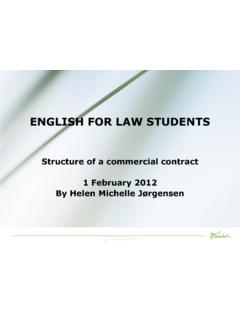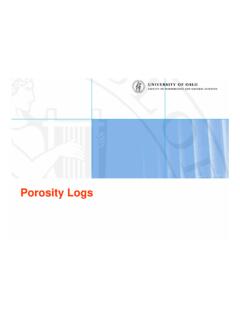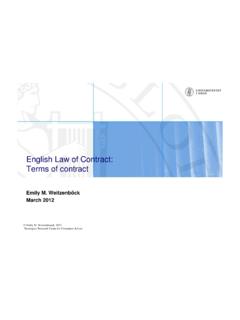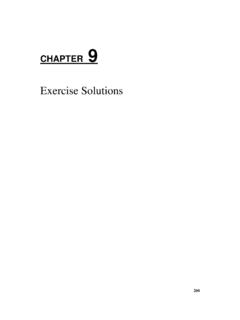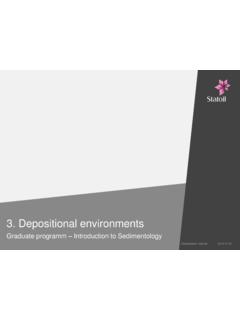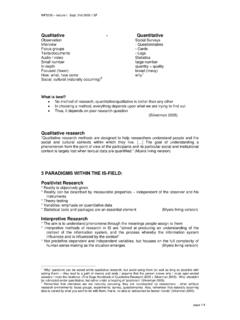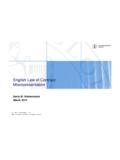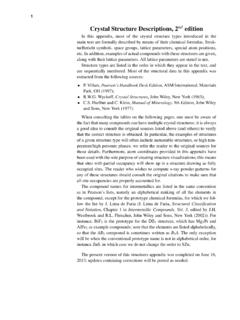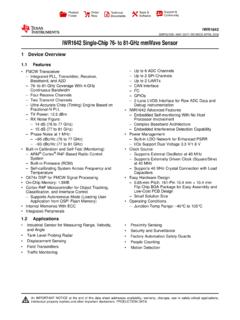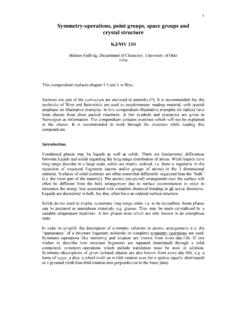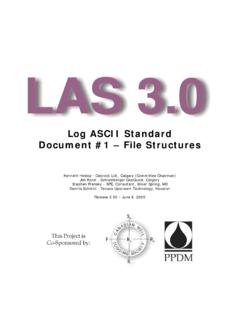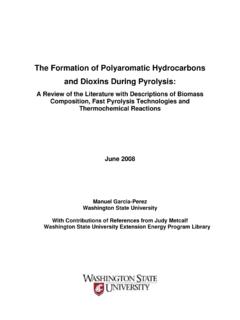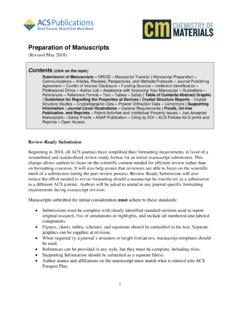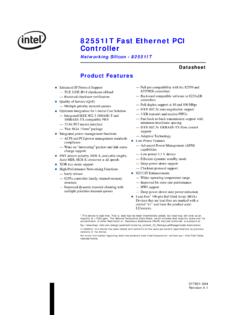Transcription of 1.17 Some important structure types a) Rock salt (NaCl ...
1 (The text is taken from: Basic Solid State Chemistry, by Anthony R. West). Some important structure types a) Rock salt (NaCl), zinc blende or sphalerite (ZnS), fluorite (CaF2), antifluorite (Na2O). These structures are considered together because they all have ccp/fcc anions and differ only in the positions of the cations. In Fig. are shown the anions in a fcc unit cell with all possible O, T+ and T- sites for the cations. The different structures are generated as fol1ows: Rock salt: O occupied; T+ and T- empty Zinc blende: T+ (or T-) occupied; O, T- (or T+) empty Antifluorite: T+, T- occupied; O empty Unit cel1s are shown in Fig. , in oblique projection (a-c) and as projections on the ab face of the unit cel1 in (d-f). Bach is described in more detail later. A general rule regarding coordination numbers is that in any structure of formula AxXy,the coordination numbers of A and X must be in the ratio of y: x.
2 In both rock salt and zinc blende, x = y and therefore, in each, anions and cations have the same coordination number. In antifluorite, of formula A2X, the coordination numbers of cation and anion must be in the ratio of 1:2. Since the cations occupy tetrahedral sites, the anioncoordination number must be eight. In order to see this, it is convenient to redefine the origin of the unit cell to coincide with a cation rather than an anion. This is done by displacing the unit cell along a body diagonal by one quarter of the length of the diagonal. The cation at X in Fig. (c), with coordinates , may be chosen as the new origin of the unit cell. The co- ordinates of all atoms in the new cell are given by subtracting from their coordinates in the old cell, as in the following table.
3 1. In cases where negative coordinates occur as a result of this subtraction, - - - , the position lies outside the new unit cell and it is necessary to find an equivalent position within the unit cell. In this particular case, 1 is added to each coordinate, giving . Addition of 1 to, say, the x coordinate is equivalent to moving to a similar position in the next unit cell in the x direction. The new unit cell of antifluorite with its origin at cation X, is shown in Fig. (a). It contains cations at corners, edge centres, face centres and body centre. In order to see the anion coordination more clearly, the unit cell may be imagined as divided into eight smaller cubes (as in Fig. ). Each smaller cube has cations at all eight corners and at the centre of each is an eight-coordinate site.
4 Anions occupy four of these eight smaller cubes such that parallel to the cell axes the eight coordinate sites are alternately occupied and empty. The eightfold coordination for one anion, A, is shown in Fig. (b). In the antifluorite structure , the effect of changing the origin from an anion to a cation is to show the structure in a completely different light. This does not happen with the rock salt and zinc blende structures. In these the cation and anion positions are interchangeable and it is immaterial whether the origin coincides with an anion or a cation. So far the NaCl, ZnS and Na2 Ostructures have been described in two ways: (a) as cp structures; and (b) in terms of their unit cells. A third way is to regard them as built of space- filling polyhedra. Each ion and its nearest neighbours may be represented by the appropriate polyhedron, in zinc blende a tetrahedron represents one Zn with four S neighbours (or vice versa).
5 It is then necessary to consider how neighbouring polyhedra are linked in 3D. Let us now consider each of these structures in more detail. i) Rock salt structure To summarize, the rock salt structure has ccp/fcc anions with octahedral sites fully occupied by cations and tetrahedral sites empty. Each cation is surrounded by six anions and similarly, each anion is octahedrally coordinated by cations (to see this, consider the anion at the body centre, 111, in Fig. ; it has six cation nearest neighbours at the six face centre positions). 2. The (NaCl6) or (ClNa6) octahedra share common edges, Fig. Since each has twelve edges and each edge is common to two octahedra it is difficult to represent this satisfactorily in a drawing; Fig. shows two such linkages. A simplified perspective which focuses on the 3D array of octahedra is shown in Fig.
6 ; also shown, arrowed, are the empty tetrahedral sites. Each octahedron face is parallel to a cp layer of anions, as emphasized by the numbering or shading of coplanar faces. Parts of four different sets of faces are seen, corresponding to the four cp orientations in a ccp/fcc array. A large number of AB compounds possess the rock salt structure . A selection is given in Table together with values of the a dimension of the cubic unit cell. Most halides and hydrides of the alkali metals and Ag+ have this structure , as do a large number of chalcogenides (oxides, sulphides, etc.) of divalent metals. Many are ionic but others are metallic, TiO, or covalent, TiC. 3. ii) Zinc blende ( sphalerite ) structure The zinc blende structure has ccplfcc anions with cations in one set of tetrahedral sites, either T+ or T.
7 The ZnS4 tetrahedra are linked at their corners and each corner is common to four such tetrahedra. The unit cell of zinc blende, Fig. (b), is shown again in Fig. (a), but in terms of corner-sharing ZnS4 tetrahedra. The faces of the tetrahedra are parallel to the cp anion layers, the {111} planes; this is emphasized in a more extensive model of the structure in (b), in which the model is oriented so that one set of tetrahedron faces is approximately horizontal. Conventionally, ZnS is regarded as built of cp layers of sulphide anions with the smaller zinc cations in tetrahedral sites. Since the same structure is generated by interchanging the Zn and S, the structure could also be described as a cp array of Zn with S. occupying one set of tetrahedral sites. A third, equivalent description is as an array of ccp ZnS4 (or SZn4) tetrahedra.
8 Some compounds with the zinc blende structure are listed in Table The bonding is less ionic than in rock salt structure compounds. Thus, oxides do not usually have the zinc blende structure (ZnO, not included in Table , is an exception; it is dimorphic with zinc blende and wurtzite structure polymorphs). Chalcogenides of the a1ka1ine earth metals (but not Be). have the rock salt structure whereas the chalcogenides of Be, Zn, Cd and Hg have the zinc blende structure , as do copper(I) halides and -AgI. A range of III-V compounds ( elements from Groups III and V of the periodic table have the zinc blende structure and some, GaAs, are important semiconductors). 4. iii) Antifluorite/fluorite structure The antifluorite structure has ccplfcc anions with cations in all (T+ and T-) tetrahedral sites.
9 The difference between antifluorite and fluorite is that anti- fluorite refers to an anion array with tetrahedral cations, whereas fluorite has the inverse arrangement with a ccp cation array and tetrahedral anions. Since the cation: anion ratio is 2:1 in antifluorite and the cation coordination is 4, the anion coordination must be 8, Fig. The very different coordination environments of anions and cations leads to two entirely distinct descriptions of the structure in terms of a 3D network of either tetrahedra or cubes, Fig. ; (a) corresponds to the arrangement shown in Fig. ( c) and the tetrahedra are highlighted; (b) corresponds to the arrangement in Fig. (b) in which the cubic coordination arrangement is highlighted. A more extended network of corner- and edge- sharing cubes is shown in (c).
10 This must surely rate as one of the world's largest models of the antifluorite structure ! The antifluorite structure is shown by a large number of oxides and other chalcogenides of the alkali metals, Table , compounds of general formula A2+X2-. A group of fluorides of large, divalent cations and oxides of large tetravalent cations, have the inverse, fluorite structure , M2+F2 and M4+O2. From Fig (b) and (c), an alternative way of describing the fluorite structure is as a primitive cubic array of anions in which the eight-coordinate sites at the cube body centres are alternately empty and occupied by a cation. It should be stressed that the true lattice type of fluorite is fcc and not primitive cubic, since the primitive cubes represent only a small part (one eighth) of the fcc unit cell.
